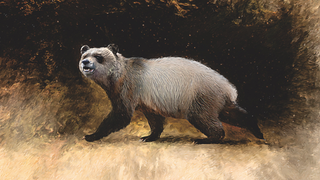The last panda in Europe is a weak giant who can't even eat bamboo
(opens in a new tab)
A pair of fossilized teeth in the museum’s collection was recently revealed when pandas last roamed Europe.
When the researchers examined the teeth, which had been in storage for about 40 years, they found that the fossils belonged to an ancient European panda species that had never been seen before. The newly discovered species, which is a close relative of the modern giant panda, roamed the continent about 6 million years ago and was likely the last panda in Europe.
The teeth – the upper canines and upper molars – were originally excavated in the late 1970s from a site in northwestern Bulgaria, but were eventually housed in the Bulgarian National Museum of Natural History in Sofia. The teeth were never properly cataloged, and as a result they were left untouched for decades. But when museum staff recently discovered an unusual tooth, they decided to investigate further.
After analyzing the teeth, the researchers realized they belonged to an ancient European panda, but the fossil was unlike any other tooth from a panda species previously identified in Europe. Most European panda species have smaller teeth than modern pandas Giant pandas (Ailuropoda melanoleuca), meaning they were probably much smaller than their modern-day cousins. But a new species, which has been given a name Agriarktos nikolovi, had teeth that were much larger than usual for a European panda, so they were most likely similar in size to today’s giant pandas. The teeth are also more recent than other European panda fossils, some of which date back more than 10 million years, suggesting that A. nikolovi most likely the last panda species to live on the continent.
“This discovery shows how little we know about the primeval realm,” study co-author Nikolai Spassov, a paleontologist at Bulgaria’s National Museum of Natural History, said. said in a statement (opens in a new tab). The fact that the newly described species derives from specimens discovered in the 1970s also “suggests that historic discoveries in paleontology can yield unexpected results, even today,” said Spassov.
Related: The oldest DNA from a giant panda has just been discovered in a cave in China
Despite the size similarity between A. nikolovi and the surviving giant panda, the newly described species “is not a direct ancestor of the modern genus,” Spassov said. But “it is a close relative.” However, the new species most likely lived in a very different habitat to today’s pandas, he added.
The petrified teeth were originally found in coal deposits, which partially dyed bear chompers black. The composition of coal in the location indicates that the area was formerly a swamp forest. This means that A. nikolovi probably had a much more varied diet than modern pandas, feasting on a variety of soft vegetation rather than exclusively on one type of plant, such as the modern panda’s diet of choice: bamboo.
Interestingly, the giant panda’s digestive system appears to be capable of processing meat, as other bears do, but they stick to a strictly vegetarian diet. Previous research has shown that giant pandas switched to a bamboo diet because they were unable to compete with other bears, the statement said. Researchers think A. nikolovi they may also have faced similar evolutionary pressures to adopt a vegetarian diet, as their teeth were much weaker than those of modern pandas, meaning they probably couldn’t even chew bamboo, much less something as hard as animal bones.
(opens in a new tab)
The study authors also suspect that A. nikolovi may eventually perish as climate change affects their habitat and diet.
“Possible climate change at the end of the Miocene [23 million to 5.3 million years ago] in southern Europe had an adverse effect on the existence of the last European panda,” said Spassov A. nikolovi may be particularly vulnerable to an event that occurred about 6 million years ago: the “Messianic salinity crisis”, when the Mediterranean Sea almost completely dried up, which had serious repercussions for terrestrial ecosystems. The ancient panda swamp forest may have become much drier and warmer, making plants harder to grow and possibly starving the pandas, the statement said.
The team remains unsure about how exactly A. nikolovi and other extinct European pandas related to the giant panda and the ancient Asian panda. It is currently unclear whether pandas first came from Asia and migrated to Europe, or vice versa. However, the researchers suspect that pandas originated in Europe more likely because fossil evidence suggests that “the oldest members of this bear group were found in Europe,” Spassov said. missing pandas, they probably won’t explain this particular mystery, scientists report.
The study was published online on July 31 at Journal of Vertebrate Paleontology (opens in a new tab).
Originally published in Live Science.
#panda #Europe #weak #giant #eat #bamboo


Comments
Post a Comment